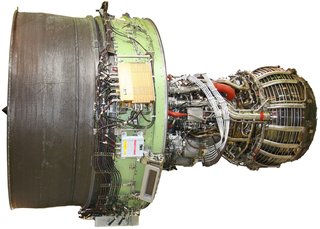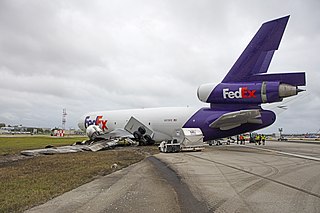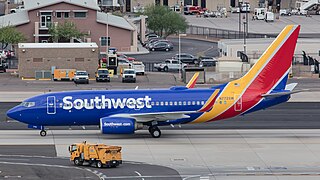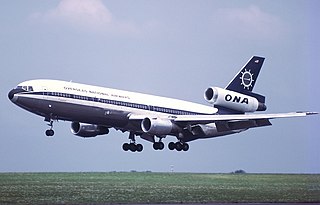
The Boeing 767 is an American wide-body airliner developed and manufactured by Boeing Commercial Airplanes. The aircraft was launched as the 7X7 program on July 14, 1978, the prototype first flew on September 26, 1981, and it was certified on July 30, 1982. The initial 767-200 variant entered service on September 8, 1982, with United Airlines, and the extended-range 767-200ER in 1984. It was stretched into the 767-300 in October 1986, followed by the extended-range 767-300ER in 1988, the most popular variant. The 767-300F, a production freighter version, debuted in October 1995. It was stretched again into the 767-400ER from September 2000.

The McDonnell Douglas DC-10 is an American trijet wide-body aircraft manufactured by McDonnell Douglas. The DC-10 was intended to succeed the DC-8 for long-range flights. It first flew on August 29, 1970; it was introduced on August 5, 1971, by American Airlines.

Delta Air Lines Flight 1141 was a scheduled domestic passenger flight between Dallas/Fort Worth, Texas and Salt Lake City, Utah. On August 31, 1988, the flight, using a Boeing 727-200 series aircraft, crashed during takeoff, resulting in 14 deaths and 76 injuries of the 108 on board.

United Airlines Flight 232 was a regularly scheduled United Airlines flight from Stapleton International Airport in Denver to O'Hare International Airport in Chicago, continuing to Philadelphia International Airport. On July 19, 1989, the DC-10 serving the flight crash-landed at Sioux Gateway Airport in Sioux City, Iowa, after suffering a catastrophic failure of its tail-mounted engine due to an unnoticed manufacturing defect in the engine's fan disk, which resulted in the loss of many flight controls. Of the 296 passengers and crew on board, 112 died during the accident, while 184 people survived. 13 of the passengers were uninjured. It was the deadliest single-aircraft accident in the history of United Airlines.

The Pratt & Whitney PW4000 is a family of dual-spool, axial-flow, high-bypass turbofan aircraft engines produced by Pratt & Whitney as the successor to the JT9D. It was first run in April 1984, was FAA certified in July 1986, and was introduced in June 1987. With thrust ranging from 50,000 to 99,040 lbf, it is used on many wide-body aircraft.

The General Electric GEnx is an advanced dual rotor, axial flow, high-bypass turbofan jet engine in production by GE Aerospace for the Boeing 747-8 and 787. The GEnx succeeded the CF6 in GE's product line.

The General Electric CF6, US military designations F103 and F138, is a family of high-bypass turbofan engines produced by GE Aviation. Based on the TF39, the first high-power high-bypass jet engine, the CF6 powers a wide variety of civilian airliners. The basic engine core also powers the LM2500 and LM6000 marine and power generation turboshafts. It is gradually being replaced by the newer GEnx family.

A turbine engine failure occurs when a turbine engine unexpectedly stops producing power due to a malfunction other than fuel exhaustion. It often applies for aircraft, but other turbine engines can fail, like ground-based turbines used in power plants or combined diesel and gas vessels and vehicles.

On December 20, 1972, North Central Airlines Flight 575 and Delta Air Lines Flight 954 collided on a runway at O'Hare International Airport in Chicago, Illinois, in the United States. Ten people died – all on the North Central aircraft – and 17 were injured in the accident. This was the second major airliner accident to happen in Chicago in December 1972; the other was United Airlines Flight 553, which crashed twelve days earlier on approach to Midway Airport.

United Airlines Flight 2885 was a scheduled cargo flight from Cleveland to Los Angeles, with stopover in Detroit. On January 11, 1983, a DC-8 operating as Flight 2885 crashed after take-off from Detroit, killing all three crew members. The National Transportation Safety Board (NTSB) investigation determined that the cause for the crash was pilot error. A radioactive package was found on board, but no radioactive material was spilled.

Delta Air Lines Flight 1288 was a regularly scheduled flight from Pensacola, Florida to Atlanta, Georgia. On July 6, 1996, the aircraft serving the flight, a McDonnell Douglas MD-88, was on takeoff roll from Runway 17 at Pensacola when it experienced an uncontained, catastrophic turbine engine failure that caused debris from the front compressor hub of the left engine to penetrate the left aft fuselage. The cause of the engine failure was found to have been a fault in the manufacture of the fan. The failure of the airline to spot the resulting crack in the blade was a contributing factor.

British Airways Flight 2276 was a scheduled international passenger service from Las Vegas to London. On 8 September 2015, the Boeing 777-200ER operating the flight suffered an uncontained engine failure and fire in the left (#1) GE90 engine during take-off from Las Vegas-McCarran International Airport, prompting an aborted take-off and the evacuation of all passengers and crew. All 170 people on board survived, but 20 were injured.

On 27 May 2016, a Boeing 777-300 of Korean Air, operating as Korean Air Flight 2708 from Haneda Airport in Tokyo to Seoul's Gimpo International Airport, was accelerating for take off when its left engine suffered an uncontained failure and a substantial fire ensued. The crew aborted the take-off, and after the aircraft came to a stop the fire was extinguished by the airport emergency services. All 319 passengers and crew were evacuated; 12 occupants were injured. The accident was attributed to poor maintenance standards and failure of the crew to carry out the emergency procedures correctly.

On October 28, 2016, FedEx Express Flight 910, a McDonnell Douglas MD-10-10F flying from Memphis International Airport to Fort Lauderdale–Hollywood International Airport was involved in a runway skid after a landing gear collapse, which resulted in a fire completely destroying the left engine and wing. Two crew members, the only people on board, were unharmed.

Southwest Airlines Flight 1380 was a Boeing 737-700 that experienced a contained engine failure in the left CFM International CFM56 engine after departing from New York–LaGuardia Airport en route to Dallas Love Field on April 17, 2018. The engine cowl was broken in the failure, and cowl fragments damaged the fuselage, shattering a cabin window and causing explosive depressurization of the aircraft. Other fragments caused damage to the wing. The crew carried out an emergency descent and diverted to Philadelphia International Airport. One passenger was partially ejected from the aircraft and sustained fatal injuries, while eight other passengers sustained minor injuries. The aircraft was substantially damaged.

Pan Am Flight 799 was an international cargo flight from Los Angeles International Airport to Cam Ranh Airport in South Vietnam that crashed on December 26, 1968, near Anchorage, Alaska. The aircraft involved was a Boeing 707-321C aircraft operated by Pan American World Airways. All three crew members died in the crash.

On February 20, 2021, United Airlines Flight 328 (UA328/UAL328), a scheduled U.S. domestic passenger flight from Denver to Honolulu, suffered what was technically ruled a contained engine failure despite shedding large pieces of debris, approximately four minutes after takeoff from Denver International Airport (DEN). Parts departing from the engine cowling of the Boeing 777-222 aircraft resulted in a debris field at least 1 mile (1.6 km) long over suburban residential areas of Broomfield, Colorado. Falling debris was recorded by eyewitnesses using smartphone cameras and a dash cam. Debris fell through the roof of a private home and significantly damaged a parked vehicle.

Tower Air Flight 41 was a scheduled domestic passenger flight from John F. Kennedy International Airport (JFK) in New York City, to Miami International Airport (MIA) in Florida. On December 20, 1995, the Boeing 747-100 operating the flight veered off the runway during takeoff from JFK. All 468 people on board survived, but 25 people were injured. The aircraft was damaged beyond repair and written off, making the accident the 25th hull loss of a Boeing 747. The National Transportation Safety Board (NTSB) concluded that the captain had failed to reject the takeoff in a timely manner.

Overseas National Airways (ONA) Flight 032 was a non-scheduled positioning flight operated by Overseas National Airways with a McDonnell Douglas DC-10-30CF. On November 12, 1975, the flight crew initiated a rejected takeoff after accelerating through a large flock of gulls at John F. Kennedy International Airport, resulting in a runway excursion. Of the 139 aircraft occupants, all survived, while the aircraft was destroyed by an intense post-crash fire. The National Transportation Safety Board concluded that the probable cause of the accident was bird ingestion into the right-hand engine, causing an uncontained engine failure that ruptured several landing gear tires and disabled the engine's hydraulic system, in turn partially disabling the spoilers and the landing gear brakes. Contributing to the accident was the resultant failure of the affected engine's thrust reverser and the wet runway. The accident aircraft is claimed to be the largest commercial airliner ever destroyed due to a bird strike.





















